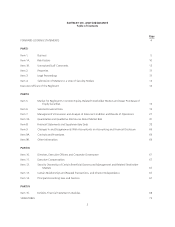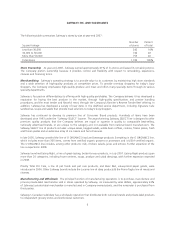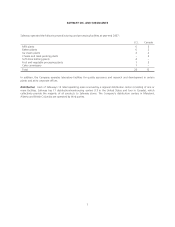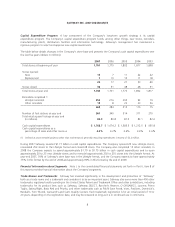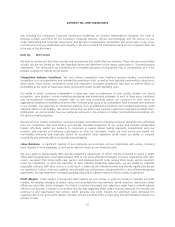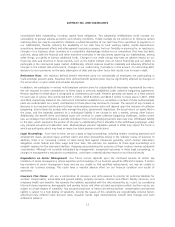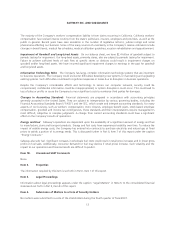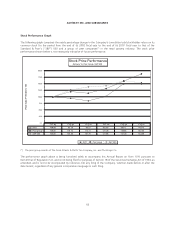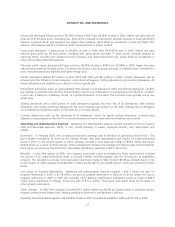Safeway 2007 Annual Report Download - page 34
Download and view the complete annual report
Please find page 34 of the 2007 Safeway annual report below. You can navigate through the pages in the report by either clicking on the pages listed below, or by using the keyword search tool below to find specific information within the annual report.SAFEWAY INC. AND SUBSIDIARIES
consolidated debt outstanding, including capital lease obligations. This substantial indebtedness could increase our
vulnerability to general adverse economic and industry conditions. If debt markets do not permit us to refinance certain
maturing debt, we may be required to: dedicate a substantial portion of our cash flow from operations to payments on
our indebtedness, thereby reducing the availability of our cash flow to fund working capital, capital expenditures,
acquisitions, development efforts and other general corporate purposes; limit our flexibility in planning for, or reacting to,
changes in our business; place ourselves at a competitive disadvantage relative to our competitors that have less debt;
and limit, along with the financial and other restrictive covenants in the documents governing our indebtedness, among
other things, our ability to borrow additional funds. Changes in our credit ratings may have an adverse impact on our
financing costs and structure in future periods, such as the higher interest costs on future financings and our ability to
participate in the commercial paper market. Additionally, interest expense could be materially and adversely affected by
changes in the interest rate environment, changes in our credit rating, fluctuations in the amount of outstanding debt,
decisions to incur premiums on the early redemption of debt and any other factor that results in an increase in debt.
Retirement Plans We maintain defined benefit retirement plans for substantially all employees not participating in
multi-employer pension plans. Expenses from defined benefit pension plans may be significantly affected by changes in
the actual return on plan assets and actuarial assumptions.
In addition, we participate in various multi-employer pension plans for substantially all employees represented by unions.
We are required to make contributions to these plans in amounts established under collective bargaining agreements.
Pension expense for these plans is recognized as contributions are made. Benefits generally are based on a fixed amount
for each year of service. We contributed $270.1 million, $253.8 million and $234.5 million to these plans in 2007, 2006
and 2005, respectively. Based on the most recent information available to us, we believe a number of these multi-employer
plans are underfunded. As a result, contributions to these plans may continue to increase. The amount of any increase or
decrease in our required contributions to these multi-employer pension plans will depend upon the outcome of collective
bargaining, actions taken by trustees who manage the plans, government regulations, the actual return on assets held in
the plans, and the potential payment of a withdrawal liability if we choose to exit a market, among other factors.
Additionally, the benefit levels and related issues will continue to create collective bargaining challenges. Under current
law, an employer that withdraws or partially withdraws from a multi-employer pension plan may incur withdrawal liability
to the plan, which represents the portion of the plan’s underfunding that is allocable to the withdrawing employer under
very complex actuarial and allocation rules. Multi-employer pension legislation passed in 2006 may impact the funds in
which we participate, which may have an impact on future pension contributions.
Legal Proceedings From time to time, we are a party to legal proceedings, including matters involving personnel and
employment issues, personal injury, antitrust claims and other proceedings arising in the ordinary course of business. In
addition, there is an increasing number of cases being filed against companies generally, which contain class-action
allegations under federal and state wage and hour laws. We estimate our exposure to these legal proceedings and
establish reserves for the estimated liabilities. Assessing and predicting the outcome of these matters involves substantial
uncertainties. Although not currently anticipated by management, unexpected outcomes in these legal proceedings, or
changes in management’s evaluations or predictions, could have a material adverse impact on our financial results.
Dependence on Senior Management Our future success depends upon the continued services of certain key
members of senior management, whose expertise and knowledge of our business would be difficult to replace. If certain
key members of senior management leave and we are unable to find qualified replacements, we may be unable to
execute our business strategy. This could have a material adverse effect on our financial condition and results of
operations.
Insurance Plan Claims We use a combination of insurance and self-insurance to provide for potential liabilities for
workers’ compensation, automobile and general liability, property insurance, director and officers’ liability insurance, and
employee health care benefits. We estimate the liabilities associated with the risks retained by us, in part, by considering
historical claims experience, demographic and severity factors and other actuarial assumptions which, by their nature, are
subject to a high degree of variability. Any actuarial projection of losses concerning workers’ compensation and general
liability is subject to a high degree of variability. Among the causes of this variability are unpredictable external factors
affecting future inflation rates, discount rates, litigation trends, legal interpretations, benefit level changes and claim
settlement patterns.
12



